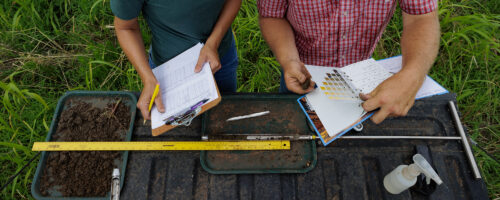Useful apps for regenerative ranching
Track ranch and soil health progress and more with these (mostly) free smartphone apps.
For many ranchers, sale day is their primary marker of progress. But the price called after the gavel drops or you shake hands on the deal doesn’t always tell the full story.
Noble Research Institute’s regenerative ranching manager Josh Gaskamp says a handful of simple, free smartphone applications can help streamline monitoring and measurement efforts on your way to your regenerative ranching goals.
“A lot of these are tools ranchers can use to track their progress,” Gaskamp says. “You get a snapshot in time that tells you what plants you’re seeing in your pasture, when you moved those cattle to what paddock, what the condition of your soil was before you started a new management practice.”
Whatever that data point is, if it is stored in your smartphone or a digital app, it’s easily accessible and searchable to track progress over time.
Gaskamp and several Noble regenerative ranching advisors share how they use these (mostly) free apps on the ranch.
Start with the apps you already have on your phone
The most useful apps on your smartphone may be the ones you already have. No matter what your ranch and soil health goals are – increased diversity, ground cover, grazing capacity, etc. – your camera app may be the most powerful tool for tracking them.
“It’s a cliché, but a picture really is worth a thousand words,” Gaskamp says. If you organize your digital photos in specific folders or albums – for example, “Range monitoring, west school section,” – you can easily compare and contrast between years at each site.
Your paper calving notebook might be your front-pocket guide to tracking your herd, but what if you took a photo of each page as it fills? Put it in an appropriately labeled digital folder, too, and you’ll have a copy that can’t get smeared with muck or become soggy beyond recognition (or lost). Plus, you can search “1175” in your photo library and image recognition will likely find the photo containing the tag number you want for quick reference.
It may help to place images into your phone’s default note-taking app, too, and then record information and data points alongside the photos.
Your notes app can also serve as a running log of ranch activities that becomes keyword-searchable. If you jot down a sentence or a few bullet points about activities or events on the ranch each day, you can later search for “vaccine” to find your vaccine order from last year, or search “Smith pasture” to remember what date you moved those pairs.

Set reminders to build new habits
Putting a new app to good use or introducing a new habit to your existing app use often fails because it’s not routine. Gaskamp suggests using another standard, pre-installed app to aid in habit formation: the calendar app.
For example, he’s working to transfer his personal ranch information into a digital bookkeeping system. Rather than just tossing receipts in the visor of his pickup after each purchase, his goal is to get in the habit of snapping a photo to upload to his bookkeeping app that syncs the proof of purchase with his banking statement. He may not remember to do it every time, but he can set a weekly reminder in his calendar. The reminder could be as specific as asking his phone to remind him every Friday when he gets home to clear the visor and process receipts before he walks in the door.
Set annual or quarterly repeating calendar reminders for rangeland monitoring; note appointments with your ranch team to review annual goals; or prompt a quick, monthly financial data review to make sure your new enterprise is on budget.
Apps focused on the soil health principles
The South Dakota Soil Health Coalition’s Soil Health Assessment app offers a quick overview of soil health principles, plus a self-assessment tool to track and evaluate qualities like ground cover, erosion, soil structure, disturbance, diversity and more.
The Soil Web app was developed by the California Soil Resource Lab at UC Davis in collaboration with the USDA. It indicates soil taxonomy, soil properties, land classification, hydraulic and erosion ratings, forest productivity and soil suitability ratings using either GPS location data or searchable locations. This information may offer indicators of your progress on your ranch, or offer additional information when you’re considering buying or leasing new land.
Land PKS, another free app, offers similar information plus historic vegetation trends, historical weather data, and places to add your own data about soil texture, slope, infiltration, other soil health monitoring data as well as land management and farm recordkeeping.

Identify and measure plant and wildlife diversity
One of Will Moseley’s favorite apps is the SEEK app by iNaturalist. He uses the free app to identify plants, trees, insects, birds and more as he helps ranchers in their regenerative journey and in his own backyard.
“Monitoring and tracking what plants or animal species are on your land can indicate information about the success of your management on the land,” says Moseley, Noble regenerative ranching advisor.
Apps like this are often less accurate in early growth stages of grasses, but if you find a plant with a flower or seedhead, he’s found the app to be fairly accurate. You may need to employ other resources for more detailed plant identification.
The presence of grassland birds also serves as an indicator of a healthy ecosystem. The free Merlin app helps identify birds based on audio recordings with calls and photos.

Map and measure for grazing plans
Gaskamp and other Noble leaders have found Google Earth to be a powerful, free place to map and measure pastures and paddock grazing cells.
On his home ranch, Gaskamp uses Google Earth to map, measure and track grazing events. It’s a simple, intuitive, free way to get started without committing to one of the more advanced, grazing-specific app tools with subscription services.
Steven Smith, Noble regenerative ranching advisor, also uses the free app Mapulator to measure, map and create layers of grazing unit history.
Boost regenerative efforts on crop ground
If you’ve delved into cover-cropping to regenerate cropland or incorporate livestock on cash-crop land, Oklahoma State University offers some free apps that might help.
Noble’s Jim Johnson uses the Canopeo app to estimate bare ground cover. Originally developed to help small grain producers calculate bare ground verses cover in fields, he has also found it a useful tool to quickly assess and monitor ground cover in some pasture situations, too.
While OSU offers a variety of different agriculture-specific apps, other Noble advisors have found Grain Drill Calculator an especially handy tool to calibrate drills for cover-crop seeding.

Apps for building a profitable business
If you’re going to spend money to purchase an app or software, Gaskamp suggests it be one to sharpen your ranch business.
“We’re aiming for all these soil health principles, and that is very important,” Gaskamp says, “But at the end of the day, the most important thing for most ranchers is profitability.”
Quicken and Quickbooks are two of the most common accounting and financial software available. Both come with mobile-friendly apps that put the process of tracking expenses, business mileage and financial analysis statements in the palm of your hand.
There are plenty of other financial apps out there, so the most important thing is to find one you’ll actually use and stick with, Gaskamp says.
“These are tools to help us study and see our business expenses in real-time so you don’t have to wait until the end of the year to realize, ‘That enterprise wasn’t making any money,’ or, ‘That input expense isn’t sustainable,’” he says. “That’s the kind of information we need to make sure we’re truly making a profit along the way.”



Comment